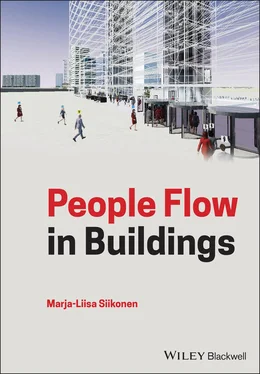6 Chapter 6Figure 6.1 Timeline of group control system development.
7 Chapter 7Figure 7.1 Push‐button hall call station (a), and a car call panel (b).Figure 7.2 Push‐button control system.Figure 7.3 Down collective control system.Figure 7.4 Functional principle of an interconnected full collective control...Figure 7.5 Landing call station (a), and lantern (b).
8 Chapter 8Figure 8.1 Collective control signalization.Figure 8.2 A quadruplex elevator group with even elevator distribution (a), ...Figure 8.3 Simulated trajectories of three elevatorsFigure 8.4 A lobby indicator showing the served floors by an elevator.Figure 8.5 Interconnected queue selective control system (IQS).
9 Chapter 9Figure 9.1 Alternative elevator routes to serve hall calls 1–4 with elevator...Figure 9.2 Conventional full collective control system architecture ( Source: Figure 9.3 Ring control system architecture where one group control is activ...Figure 9.4 Destination control architecture where the terminal requests for ...
10 Chapter 10Figure 10.1 Iterative search for global optimum on a landscape of a search s...Figure 10.2 Group control with AI Figure 10.3 A group control system with fuzzy rules and multi‐objective opti...Figure 10.4 Forecasting with exponential smoothing method with α = 0.5....Figure 10.5 A typical membership function.Figure 10.6 Fuzzy logic dispatching systemFigure 10.7 Alteration of chromosomes and genes according to the genetic alg...Figure 10.8 Principle of GA chromosomes in call allocation Figure 10.9 Artificial neuron model.Figure 10.10 A feed‐forward multilayer perceptron with one hidden layer in A...Figure 10.11 Artificial neuron model for RRT Figure 10.12 Call allocation with NN Figure 10.13 People behaviour at a main lobby with conventional control.Figure 10.14 Automated guided vehicle communication with an elevator group...
11 Chapter 11Figure 11.1 Miconic 10 implementationFigure 11.2 Signalization of traditional destination control (a), destinatio...Figure 11.3 Hybrid DCS signalization.Figure 11.4 Call allocation with GA in hybrid destination control system.Figure 11.5 Harmonized DCS signalization at elevator lobbies.Figure 11.6 People behaviour at a main lobby with DCS control system.
12 Chapter 12Figure 12.1 Functional principle of a paternoster.Figure 12.2 Odyssey system with horizontal cab transportation with APMs (a),...Figure 12.3 A double‐deck elevator (a), and DD service in up‐peak (b).Figure 12.4 Double‐deck hall call allocation with GA .Figure 12.5 Double‐deck destination call allocation with GA .Figure 12.6 Destination indicator at the entrance floor (a), hall station at...Figure 12.7 A TWIN lift system Figure 12.8 TWIN arrangement with two‐car shafts, and a single elevator shaf...Figure 12.9 MULTI exchangerFigure 12.10 Example of MULTI system (a) and building arrangement with tradi...Figure 12.11 A conveyor moving from the bottom to top of a buildingFigure 12.12 A sketch of a waiting area (a) and three cabins in one shaft (b...Figure 12.13 MCE system with two shafts and six cars
13 Chapter 13Figure 13.1 Application of access control system.Figure 13.2 An external access control system connected to destination contr...
14 Chapter 14Figure 14.1 Typical elevator bank arrangements (a–g) from four to eight elev...Figure 14.2 DCS elevator group arrangements with low and high rise in the sa...Figure 14.3 Elevator dimensions.Figure 14.4 Machine room less elevator shaft (a) and a shaft with machine ro...Figure 14.5 Lobby layouts of comparable single‐car and double‐deck elevator ...Figure 14.6 Double‐deck lobby arrangement.
15 Chapter 15Figure 15.1 Escalator arrangements: scissors (a), criss‐cross (b) and parall...Figure 15.2 Unrestricted area of an escalator (EN 115‐1 2008).Figure 15.3 Poles in front the escalator entrance.Figure 15.4 Escalator vertical dimensions (EN 115‐1 2008).Figure 15.5 Horizontal moving walkways.Figure 15.6 Dimensions of staircases.Figure 15.7 Swing door (a), sliding door (b) and revolving door (c).
16 Chapter 17Figure 17.1 Cycle time of an elevator trip. Figure 17.2 Elevator motor speed reference curves for cases A, B, C and D.Figure 17.3 Elevator round trip in up‐peak.Figure 17.4 Probability transition matrix for elevator jumps between floors ...Figure 17.5 Zoning alternatives from the left are to minimize variance of RT ...Figure 17.6 A building with a main entrance and three basements below the gr...Figure 17.7 Up‐peak handling capacity for different car passenger capacities...
17 Chapter 18Figure 18.1 Erlang service time probability distribution with a mean of one ...Figure 18.2 Passenger queue length, q w, as a function of utilization factor,...Figure 18.3 Simulated and calculated average passenger transit times in up‐p...Figure 18.4 Passenger service times in up‐peak calculated from for the round...Figure 18.5 Waiting passenger queue length, q w, for several number of destin...
18 Chapter 19Figure 19.1 Level of Service.Figure 19.2 Mixture of male and female body ellipses inside a carFigure 19.3 Theoretical passenger density on escalator steps.Figure 19.4 Relation of people flow and people density in walkways.Figure 19.5 Relationship of people flow and density in walkways and stairs....Figure 19.6 Walking speed components on stairs.
19 Chapter 21Figure Figure 21.1 Block diagram of Monte Carlo simulation of round trip tim...Figure 21.2 Passenger traffic with an elevator groupFigure 21.3 Screenshot of traffic view from commercial elevator traffic sim...Figure 21.4 Traffic view of KONE building traffic simulatorFigure 21.5 People flow simulator architectureFigure 21.6 Possible visitor routes from outside through the reception to th...Figure 21.7 KONE PFS simulator visualization of lobby traffic
20 Chapter 22Figure 22.1 Waiting time distributions as a function of number of samples...Figure 22.2 Stepwise and ramp simulation profiles.Figure 22.3 Series of ISO 8100‐32 pure up‐peak (a) and mixed up‐peak (b) off...Figure 22.4 Series of ISO 8100‐32 multitenant office (a) and single‐tenant o...Figure 22.5 Series of ISO 8100‐32 hotel traffic template (a), and CIBSE hote...Figure 22.6 Series of ISO 8100‐32 residential traffic template (a), and CIBS...
21 Chapter 23Figure 23.1 Simulated round trip times and individual realizations from simu...
22 Chapter 24Figure 24.1 Up‐peak service with a group of six cars using conventional cont...Figure 24.2 Up‐peak boosting with a group of six double‐deck elevators using...Figure 24.3 Average waiting times for zoned elevator groups with rated passe...Figure 24.4 Car load factor (a) and elevator starts per round trip (b) with ...Figure 24.5 Elevator cycle time (a), and round trip time (b) with increasing...Figure 24.6 Passenger average waiting times (a) and average times to destina...Figure 24.7 Passenger average waiting times (a) and average times to destina...Figure 24.8 Simulated and theoretical passenger waiting times with conventio...Figure 24.9 Car load factor (a), and elevator starts per round trip (b) with...Figure 24.10 Elevator cycle time (a), and round trip time (b) with increasin...Figure 24.11 Passenger average waiting times (a) and average times to destin...Figure 24.12 Car load factor (a), and elevator starts per round trip (b) wit...Figure 24.13 Elevator cycle time (a), and round trip time (b) with increasin...Figure 24.14 Passenger average waiting times (a) and average times to destin...Figure 24.15 Car load factor (a), and elevator starts per round trip (b) wit...Figure 24.16 Elevator cycle time (a), and round trip time (b) with increasin...Figure 24.17 Passenger average waiting times (a) and average times to destin...Figure 24.18 Example of up‐peak average waiting times (a), and times to dest...Figure 24.19 Average passenger waiting time (a), and time to destination (b)...Figure 24.20 Average passenger transit time (a), and elevator round trip tim...Figure 24.21 Theoretical and simulated waiting time distribution at demand o...
Читать дальше












